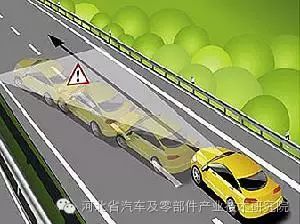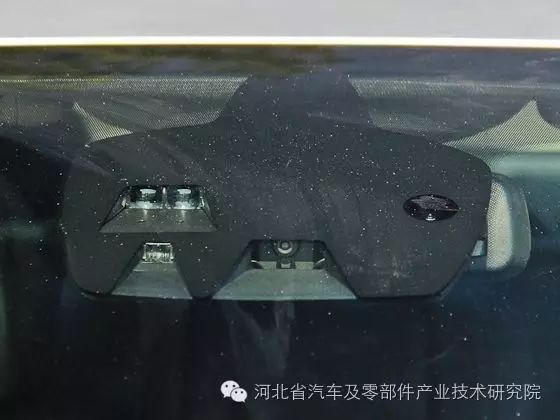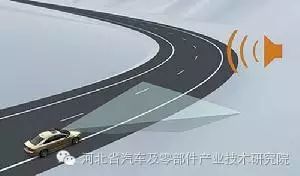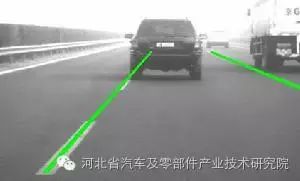 Lane Departure Warning Illustration Lane Departure Warning System is a system that assists drivers in reducing traffic accidents caused by lane departures through alarms.
Lane Departure Warning Illustration Lane Departure Warning System is a system that assists drivers in reducing traffic accidents caused by lane departures through alarms.  The basic components of the lane departure warning system include image processing chips, controllers, and sensors.
The basic components of the lane departure warning system include image processing chips, controllers, and sensors.
 This system provides intelligent lane departure warnings, capable of issuing alarms 0.5 seconds before the vehicle unintentionally (without the driver using turn signals) departs from its lane, giving the driver more reaction time and significantly reducing collisions caused by lane departures. Additionally, using LDWS can correct the habit of drivers not using turn signals; the system’s main function is to alert drivers who are overly fatigued or to address attention issues caused by long monotonous driving.
This system provides intelligent lane departure warnings, capable of issuing alarms 0.5 seconds before the vehicle unintentionally (without the driver using turn signals) departs from its lane, giving the driver more reaction time and significantly reducing collisions caused by lane departures. Additionally, using LDWS can correct the habit of drivers not using turn signals; the system’s main function is to alert drivers who are overly fatigued or to address attention issues caused by long monotonous driving.  Lane Departure Warning System Automotive safety experts point out that about 50% of automotive traffic accidents are caused by vehicles departing from their normal lanes, primarily due to drivers being distracted, inattentive, or fatigued.
Lane Departure Warning System Automotive safety experts point out that about 50% of automotive traffic accidents are caused by vehicles departing from their normal lanes, primarily due to drivers being distracted, inattentive, or fatigued.
Return to Table of Contents ↑2. English Name Card
Lane Departure Warning System, abbreviated as LDWS
Return to Table of Contents ↑3. Research Background
Research Background of Lane Departure Warning According to estimates from the (U.S.) Federal Highway Administration, 44% of all fatal traffic accidents in the U.S. in 2002 were related to lane departures, and lane departures are also considered a major cause of vehicle rollover accidents. Analysis results from the AssistWare website indicate that 23% of drivers have fallen asleep at the wheel at least once in a month; 66% of truck drivers have dozed off while driving; and 28% of truck drivers have had experiences of falling asleep at the wheel within a month. One in four drivers has experienced casualties due to lane departure accidents.
Return to Table of Contents ↑4. Principles and Functions
According to the (U.S.) National Highway Traffic Safety Administration’s definition, a lane departure warning system is a system that assists drivers in avoiding or reducing lane departure accidents through alarms. A lane departure warning system does not attempt to control the vehicle to prevent potential collision accidents. The “Road Departure Collision Warning Project Using Intelligent Vehicle Road Systems” conducted by the National Highway Traffic Safety Administration categorizes lane departure warning systems into two main functions: “longitudinal” and “lateral” lane departure warnings. The longitudinal lane departure warning system is primarily used to prevent lane departure collisions caused by excessive speed or loss of control, while the lateral lane departure warning system is primarily used to prevent lane departure collisions caused by driver inattention and relinquishing steering control.


Return to Table of Contents ↑5. Classification of Visual Systems
The lane departure warning systems that have been commercially utilized are all based on visual systems. Depending on the installation position of the camera, these systems can be classified into: Side View System – where the camera is installed on the side of the vehicle, angled towards the lane; Front View System – where the camera is installed at the front of the vehicle, angled towards the front lane. Whether it is a side view system or a front view system, it consists of three basic modules: road and vehicle state perception, lane departure evaluation algorithms, and signal display interfaces. The system first perceives the geometric features of the road and the dynamic parameters of the vehicle through the state perception module, then evaluates the possibility of lane departure using the lane departure evaluation algorithm, and if necessary, alerts the driver through the signal display interface.
Return to Table of Contents ↑6. Classification of Warning Systems
Foreign Lane Departure Warning Systems
1. AURORA System This system was successfully developed by the Robotics Institute of Carnegie Mellon University in 1997. It consists of a color camera with a wide-angle lens, a digital converter, and a portable SunSparc workstation. The system detects lane markings next to the vehicle using a downward-facing color camera with a viewing range of approximately 1.5m-1.6m installed on the side of the vehicle, collects the camera’s video output through a digital converter, and processes it on a portable SunSparc workstation at a processing speed of 60Hz.
2. AutoVue System This system was jointly developed by the former DaimlerChrysler Company and Iteris in the U.S. It mainly consists of a camera installed behind the windshield of the car, two stereo speakers, a small display device, and a control unit. The system works by continuously monitoring the car’s position in the current lane, calculating the distance from the car to the lane markings, and comparing it with a set warning distance to determine whether to issue a warning. When it detects an impending lane departure, it emits a rumbling sound similar to that of a vehicle driving over a rumble strip to alert the driver to correct the vehicle’s position. Currently, the AutoVue system has been equipped as an option on various trucks in Europe.
3. Mobileye_AWS System This system is developed by Mobileye, headquartered in the Netherlands. It uses a single camera mounted on the front windshield to monitor lane markings, measuring and monitoring the distance between the vehicle and the road boundary. The lane departure warning module of this system predicts the time when the vehicle will cross the lane markings by detecting the road boundary, calculating the vehicle’s position relative to the lane, and its lateral movement. When this time is less than a set value, the system triggers visual and auditory warnings to prompt the driver to respond appropriately to different hazardous situations and reduce the occurrence of accidents. The system can suppress warnings in cases of conscious lane departures, braking, and absence of lane markings.
4. DSS System (Driver Support System) This system was proposed by Mitsubishi Motors in Japan in 1998 and was applied to model cars in the fall of 1999. It consists of a small CCD camera installed in the rearview mirror of the car, some sensors that detect vehicle status and driver behavior, and visual and auditory warning devices. The system uses lane markings obtained from the CCD camera, vehicle status data from other sensors, and driver operation information to determine whether the vehicle has begun to depart from its lane. If necessary, the system will alert the driver through visual warnings, auditory warnings, and vibrations in the steering wheel to drive carefully.
Domestic Lane Departure Warning Systems
1. JLUVA-1 System This system was developed by the Intelligent Vehicle Research Group at Jilin University. It is a monocular vision-based front view system, mainly consisting of an onboard power supply, an embedded microcomputer, a display device, a black-and-white CCD camera, data cables, a speaker, and an image capture card. The system uses a CCD camera installed at the rearview mirror position to capture images of the road ahead. When it detects that the vehicle is too close to the lane’s white line, potentially drifting into an adjacent lane without the driver using turn signals, the system will issue a warning to alert the driver to correct this unconscious lane departure, thereby minimizing lane departure accidents.
2. Embedded Lane Departure Warning System Based on DSP Technology This system was developed by Southeast University and is a monocular vision-based front view system. It consists of modules for analog-to-digital conversion and decoding circuits, buffering circuits, media processing DSP circuit modules, and encoding and digital-to-analog conversion circuit modules. The system captures analog video signals of the tracked lane lines through an onboard camera, decodes them to generate a digital signal stream, buffers it, and sends it to the video interface of a high-speed media processing DSP. The video processing module then extracts lane feature values from the digital video signal, and finally, the processed video signal is output for display through the encoding and digital-to-analog conversion circuit.
Return to Table of Contents ↑7. Development of Warning Systems
The research on lane departure warning systems mainly focuses on vision-based lane departure warning systems. However, from the current technological level, the primary factor affecting the reliability of vision-based lane departure warning systems is the impact of weather conditions and lighting changes, which is a major challenge faced by all vision-based systems. Currently, research on robust lane departure evaluation algorithms that can adapt to various weather conditions and overcome the impact of lighting changes and shadows is the development trend for all vision-based lane departure warning systems. Based on the trend of active safety development in automobiles and the current traffic situation in China, the automotive active safety electronics industry is gradually forming an independent system. Many industry insiders are paying attention and actively researching this field. Currently, only a few companies in China have a relatively complete development of lane departure systems, forming an independent industry, and the market introduction of lane departure systems signifies that China has entered a new era of automotive active safety.
